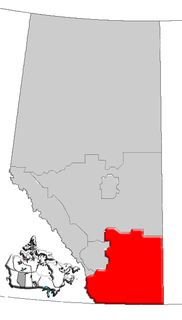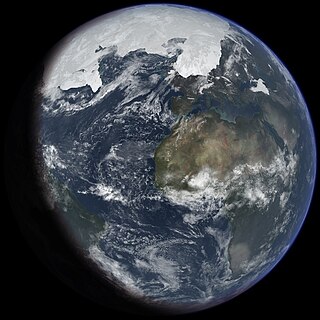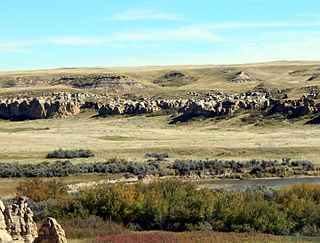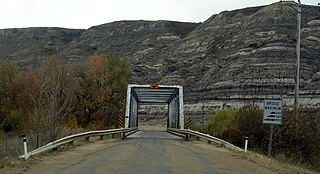| Etzikom Coulee | |
|---|---|
| Location | |
| Country | Canada |
| Physical characteristics | |
| Source | |
| ⁃ location | Stirling Lake |
| ⁃ coordinates | 49°31′44″N112°32′30″W / 49.52894°N 112.54171°W |
| ⁃ elevation | 930 meters (3,050 ft) |
| Mouth | |
⁃ location | Pakowki Lake |
⁃ coordinates | 49°23′17″N111°05′42″W / 49.38805°N 111.09504°W Coordinates: 49°23′17″N111°05′42″W / 49.38805°N 111.09504°W |
⁃ elevation | 860 meters (2,820 ft) |
| Length | ~110 kilometers (68 mi) |
Etzikom Coulee is a coulee located in Southern Alberta, Canada.

Coulee, or coulée is a term applied rather loosely to different landforms, all of which refer to a kind of valley or drainage zone. The word coulee comes from the Canadian French coulée, from the French word couler meaning "to flow".

Southern Alberta is a region located in the Canadian province of Alberta. In 2004, the region's population was approximately 272,017. The primary cities are Lethbridge and Medicine Hat. The region is known mostly for agricultural production, but other sectors, such as alternative energy, film production and tourism, are emerging.

Canada is a country in the northern part of North America. Its ten provinces and three territories extend from the Atlantic to the Pacific and northward into the Arctic Ocean, covering 9.98 million square kilometres, making it the world's second-largest country by total area. Its southern border with the United States, stretching some 8,891 kilometres (5,525 mi), is the world's longest bi-national land border. Canada's capital is Ottawa, and its three largest metropolitan areas are Toronto, Montreal, and Vancouver.
Contents
The waterway was formed as a glacial spillway channel at the end of the last ice age. [1]

An ice age is a long period of reduction in the temperature of the Earth's surface and atmosphere, resulting in the presence or expansion of continental and polar ice sheets and alpine glaciers. Earth's climate alternates between ice ages and greenhouse periods, during which there are no glaciers on the planet. Earth is currently in the Quaternary glaciation, known in popular terminology as the Ice Age. Individual pulses of cold climate within an ice age are termed "glacial periods", and intermittent warm periods within an ice age are called "interglacials" or "interstadials", with both climatic pulses part of the Quaternary or other periods in Earth's history.










